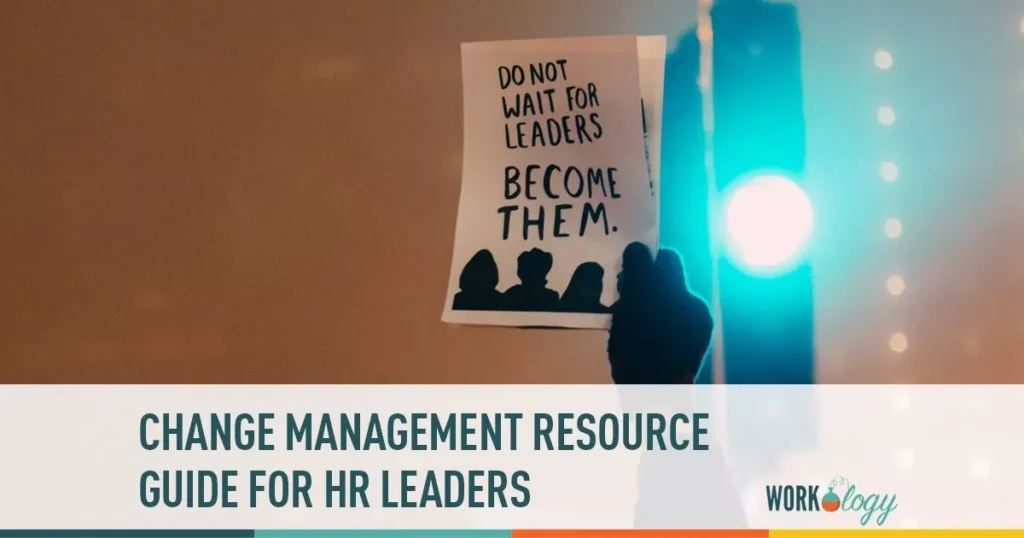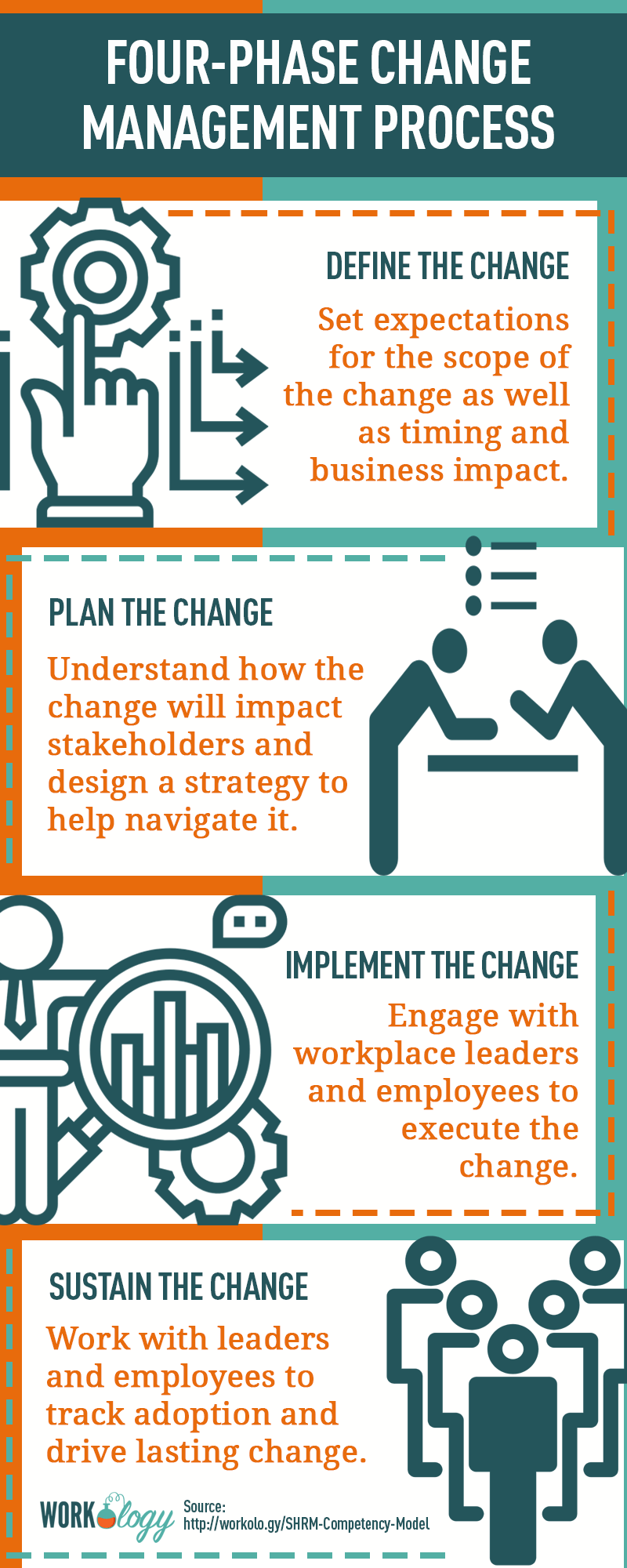As the spotlight shines a bit brighter on HR after a chaotic year, making sure that leaders can handle, process, and embrace change is essential. If we know one thing for certain, it’s that change isn’t going away.
Change Management Resource Guide for HR Leaders
Change management (sometimes abbreviated as CM) is a collective term for the approaches that prepare and support individuals, teams, and organizations in making organizational change. The most common change drivers include technological evolution, process reviews, crisis, and consumer habit changes; pressure from new business entrants, acquisitions, mergers, and organizational restructuring. It includes methods that redirect or redefine the use of resources, business processes, budget allocations, or other modes of operation that significantly change a company or organization.
As we discovered in 2020, crisis is a driver of change that feels like a ride we didn’t choose to take. Change from crisis found us struggling to create a new remote workforce, support our employees during a global health crisis, set guidelines for company leadership on how to handle communication and action, and develop scenario planning. Above all, it reminded us that the greatest challenges an HR leadership team faces come from the fact that HR is human at its core. We support our employees above all else, and the rest happens after a hierarchy of needs is met.
As far as our company business model is concerned, Gartner research reports that the typical organization today has undertaken five major firmwide changes in the past three years — and nearly 75% expect to multiply the types of major change initiatives they will undertake in the next three years. Yet half of the change initiatives fail, and only 34% are a clear success.
Understanding Resistance to Change and How to Manage It
It’s important that HR leaders take the time to build relationships across an organization. Most roadblocks can be overcome by communicating with your workforce ahead of time to convey the benefits of upcoming changes. HR can help people understand how those changes will directly benefit them as employees and help shape corporate culture by generating excitement for what lies ahead by providing rewards for innovation and compliance, as well as by setting the example of being the first in the company to adapt to change themselves.
Managing change is passive; leading change is active. The best human resource leaders not only stay a step ahead of the change within their organization, they take the reins and lead the change. In fact, the best HR leaders don’t just react to change—they act as a change agent and lead the company’s employees in a positive direction.
In the Workology Podcast Episode 260: The Role of the CHRO Leading a Global Organization with Jane Keith, CHRO of IFS, Jane talked about supporting a huge change initiative at IFS to get the global teams all on the same infrastructure and platform. I asked about how a rollout of a change this size worked for her company. She said the company brought in a change management consultant, assigned a steering committee, set up workstreams, and asked for volunteers to help lead the change. “We started by facilitating shared insights of what we wanted the outcome to be. And then we put the workstreams together. We put a lot of funding behind it and did a kick-off where we got everyone in the same country in the same room and ran a two-day workshop so that the team automatically felt connected with each other. We listened to the feedback that they gave us. We adjusted course where necessary.”
Jane shared another facet of this rollout that I thought was a great takeaway for HR leaders working to support changes within their companies. “We created super users of the tool. On the day that we launched, we had all the super users in t-shirts walking the floor of the offices, with ‘can I help you’ on the back and they would sit down and show people how to use the new tool. I mean, it was really quite exciting. We made a big buzz around it. We had stuffed up on TV screens, town halls. We really celebrated the fact that this was our product and we were kind of launching it to ourselves.” Jane made the point that while change is a process, it’s important to communicate its permanence: “Be brave and take the old versions away because people have a natural habit of going back to what they know.”
It’s important to consider where we invest time, attention, and energy to manage change. In the case of new technology, consider the timing of support. It’s common to offer support when news of a change is announced, but employees experience the reality of that change later — which is when they actually need change management support.
In the Workology Podcast Episode 247: Secrets Of HR Technology Implementation with Cheryl Gochis, CHRO of Baylor University, Cheryl talked about her experience working towards a large scale HR technology implementation with Oracle – that began during the early days of the pandemic. In-person meetings were part of Baylor’s initial strategy for their technology launch, but that quickly changed as employees began working from home. Cheryl said the implementation team looked to alumni to help create excitement and awareness around their new technology launch. And luckily, one of their university alumni was one of the actors from the popular television show, The Office. It’s a great story – have a listen to the podcast for the details – and it really highlights how important it is to create new methods, pathways, processes, and to find creative ways to generate excitement about change.
A Competency Model for Change Management
The SHRM Competency Model provides a foundation for talent management throughout the HR lifecycle and helps organizations ensure that HR professionals are proficient in the critical behaviors and knowledge necessary to solve today’s most pressing people issues and strategies, especially in the area of change management.
Within the competency of “Human Resource Expertise,” one of the sub-competencies is “change management.” In that same competency, one of the proficiency standards for mid-level HR professionals is “Implements change based on proven change-management techniques” as is “Interprets both policies and changes to policy” and “Recommends policy changes to support business needs.” Clearly, change management is an integral part of what HR professionals need to know and practice in order to become competent leaders.
At the senior level within this competency model, a proficient HR professional (according to SHRM) “Serves as a change agent for the organization,” and at the executive level, he or she “Identifies the need for and facilitates strategic organizational change,” “Oversees critical large-scale organizational changes with the support of business leaders,” “Ensures appropriate accountability for the implementation of plans and change initiatives,” “Sets tone for maintaining or changing organizational culture” and “Gains buy-in for organizational change across senior leadership with agility.”
The role of the HR leader is one of great influence. By communicating encouragement and motivation despite the challenges, HR can set the pace for the entire company to achieve success.
Project Management vs. Change Management
There are some similarities between project management and change management, but it’s important to understand the differences.










3 Comments
what is change management process flow?
How are the employees equipped for change management? Employees are at the frontline with the development, communication, and adoption of process changes, but they are often unequipped to manage changes and have to undertake changes with jerry-rigged approaches. Well-equipped employees are more confident and less resistant to administering changes.
Everything has its value. Thanks for sharing this informative information with us. GOOD works!
Comments are closed.